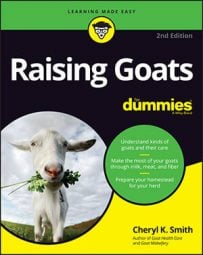You can also build a bat house for the outside of the barn or on a nearby tree. Bats eat mosquitoes and other insects, so having them around is beneficial to a farm. The only disadvantage to having bats is that they can carry rabies, which a curious goat can get from inspecting a crazy-acting bat.
To discourage mosquitoes, eliminate standing water where they can breed. If you have water that continues to build up, just pour some vegetable oil on the top to stop the mosquitoes from breeding. Or you can buy a product called Mosquito Free Water from livestock supply companies; it's safe and can be sprayed on standing water.
Some people use insecticides to control flies and other pests, and you can find many of them on the market for just this purpose. But remember: the chemicals are poison and can harm you and your goats. You probably don't want insecticides in your milk or meat. Here are some non-toxic methods for controlling flies:
-
Fly parasites: You can buy these tiny wasps, which feed on fly larvae, from biological pest control companies and some livestock supply catalogs. You get them in regular shipments through the mail and put them out through the summer near wet areas, where flies are more likely to hatch.
-
Fly strips: These are inexpensive and amazingly effective. You unwind these sticky strips and hang them with tacks around the barn. When the flies land on them they get stuck. Mr. Sticky is the most effective brand.
-
Mr. Sticky mini roll: This product is superior to fly strips because the roll lies horizontally rather than vertically, and so flies are more likely to land on it. The mini kit is perfect for a small barn. It is an 81-foot reel that you attach to the walls across a stall and roll up as it fills with flies. You can also buy a 1,000-foot roll.
-
Fly trap: You can find various fly traps on the market. One is a plastic bell-shaped trap that you fill with stinky bait and hang from the ceiling. Flies are attracted to the smell, crawl in, and then can't get out. These smell bad, so you need to place them where you won't accidentally walk into one.
-
Citronella fly spray: Citronella spray is made for horses, but you can spray it directly on goats when they are being bothered by deer flies or horse flies that are particularly aggressive.

